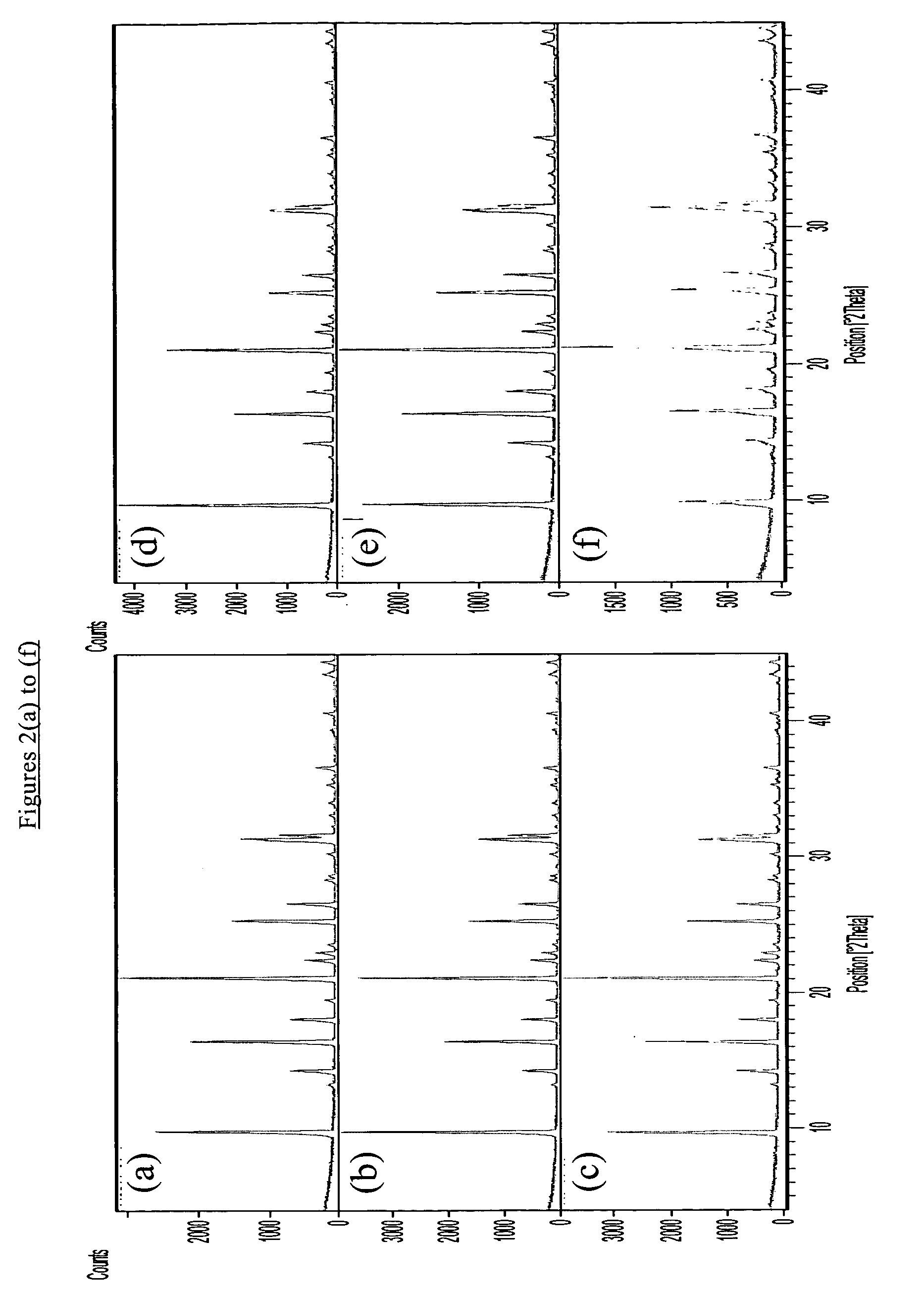Chabazite-type molecular sieve, its synthesis and its use in the conversion of oxygenates to olefins
a technology of molecular sieve and oxygenate, which is applied in the field of molecular sieve, can solve the problems of limiting catalyst life, increasing the potential for undesired secondary reactions, and lowering the diffusion rate of reactants and products
- Summary
- Abstract
- Description
- Claims
- Application Information
AI Technical Summary
Benefits of technology
Problems solved by technology
Method used
Image
Examples
example 1
[0069] 0.818 ml of a 23.5 mg / ml aqueous solution of Al(NO3)3.9H2O was added to 15.674 ml of a 0.5721 molar aqueous solution of N,N,N-trimethyl-1-adamantylammonium hydroxide (TMAA+ OH−) followed by 4.00 ml of tetraethylorthosilicate. The resultant mixture was continuously stirred in a sealed container overnight at room temperature until all the tetraethylorthosilicate was completely hydrolyzed. To the resultant clear solution was added 0.390 ml of a 48 wt % aqueous solution of hydrofluoric acid which immediately resulted in the production of a slurry. This slurry was further homogenized by stirring and exposure to air for evaporation of water and ethanol until a thick slurry mixture was obtained. Extra water was further evaporated from the slurry mixture under static conditions to give 4650 mg of a dry gel solid having the following molar composition:
SiO2:0.00143Al2O3:0.5TMAA:0.6F:5.0H2O
[0070] The resultant solid was divided into 2 approximately equal parts. To one part was added w...
example 2
[0072] The process of Example 1 was repeated but with the amount of the 23.5 mg / ml aqueous solution of Al(NO3)3.9H2O being decreased to 0.716 ml to give, after evaporation of water and ethanol, 4648 mg of a dry gel solid having the following molar composition:
SiO2:0.00125Al2O3:0.5TMA:0.6F:5.0H2O
[0073] After dividing the dry gel solid into 2 equal parts and adding 0.2 wt % of the AEI seeds to only one part, the solids were crystallized as in Example 1 to give, after washing and drying, 686 mg of a white microcrystalline solid for the seeded synthesis and 566 mg of a white microcrystalline solid for the unseeded synthesis.
[0074] The as-synthesized products of the seeded and unseeded processes had the X-ray diffraction patterns shown in FIGS. 1(b) and 2(b) respectively demonstrating that both products had a CHA structure. The silica to alumina molar ratio of each product was found to be about 800. The results of SEM analysis are shown in FIG. 3(b) for the seeded synthesis and FIG. 4...
examples 3 to 6
[0075] The process of Example 1 was repeated but with the amount of the 23.5 mg / ml aqueous solution of Al(NO3)3.9H2O being decreased to 0.636 ml (Example 3), 0.572 ml (Example 4), 0.520 ml (Example 5) and 0.478 ml (Example 6) to give, after evaporation of water and ethanol, 4646 mg, 4646 mg 4644 mg and 4644 mg, respectively, of dry gel solids having the following molar compositions:
SiO2:0.0011Al2O3:0.5TMA:0.6F:5.0H2O Example 3
SiO2:0.00100Al2O3:0.5TMA:0.6F:5.0H2O Example 4
SiO2:0.00091Al2O3:0.5TMA:0.6F:5.0H2O Example 5
SiO2:0.00083Al2O3:0.5TMA:0.6F:5.0H2O Example 6
[0076] As before, each dry gel solid was divided into 2 equal parts and the parts separately crystallized as described in Example 1 with only one of the parts containing 0.2 wt % of the AEI seeds. The results of the syntheses are summarized in Table 2.
TABLE 2Seeded SynthesisNon-seeded SynthesisExampleYield (mg)Si / Al2Yield (mg)Si / Al23669900594900464710006011000564311006451100665012006051200
[0077] X-ray diffraction patte...
PUM
| Property | Measurement | Unit |
|---|---|---|
| diameter | aaaaa | aaaaa |
| diameter | aaaaa | aaaaa |
| molar ratios | aaaaa | aaaaa |
Abstract
Description
Claims
Application Information
 Login to View More
Login to View More - R&D
- Intellectual Property
- Life Sciences
- Materials
- Tech Scout
- Unparalleled Data Quality
- Higher Quality Content
- 60% Fewer Hallucinations
Browse by: Latest US Patents, China's latest patents, Technical Efficacy Thesaurus, Application Domain, Technology Topic, Popular Technical Reports.
© 2025 PatSnap. All rights reserved.Legal|Privacy policy|Modern Slavery Act Transparency Statement|Sitemap|About US| Contact US: help@patsnap.com



